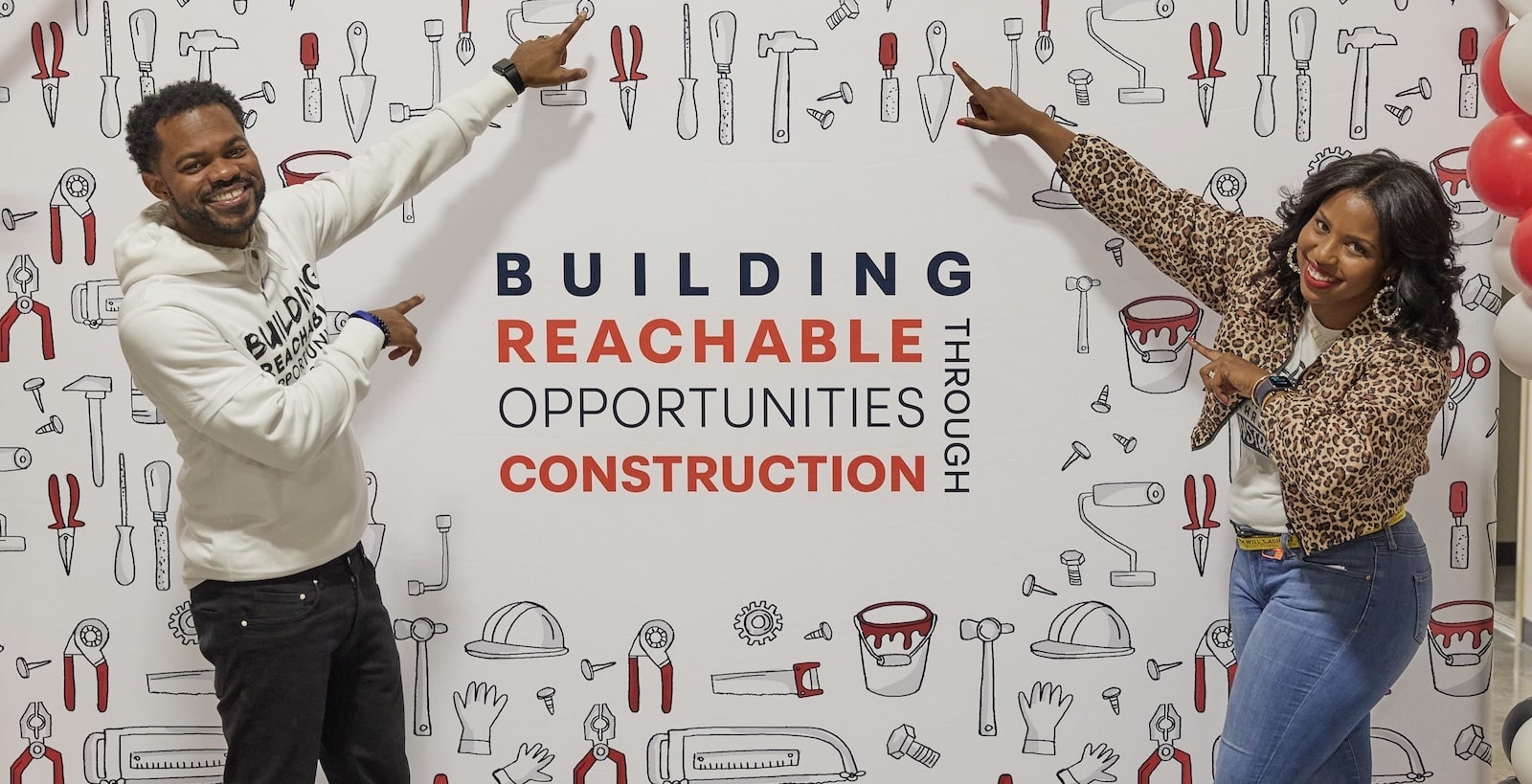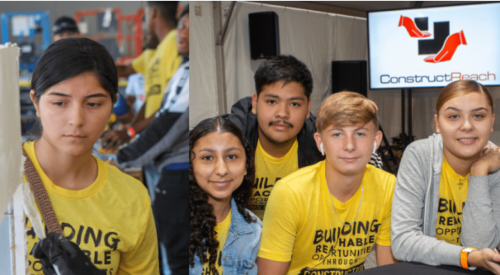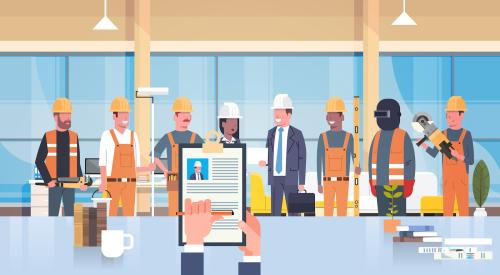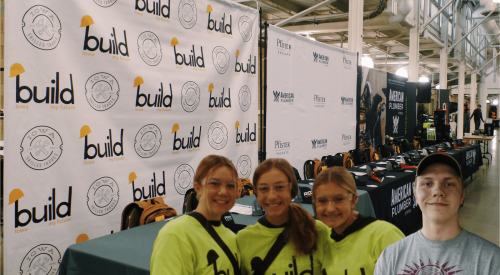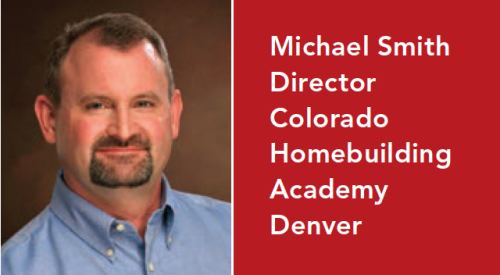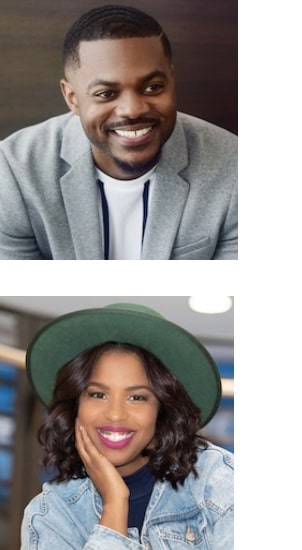
ConstructReach
Paul Robinson founded ConstructReach in 2018 to create events and a social network for educating young people, teachers, and parents about opportunities in construction. The St. Louis-based workforce development organization also helps employers become more proactive with recruitment by presenting career paths, developing curricula, and connecting with future interns and new employees.
Among its outreach efforts is “I Built This,” a collaboration with Target that includes events providing hands-on experience and tours of construction sites at the retailer’s remodels and new builds.
Paul Robinson and his wife, Ebony, who is ConstructReach’s director of community relations and business development, talk about how their organization helps employers “re-posture” and show students that the construction industry needs them and could be a good employment fit.
Bridging the Gap in the Construction Labor Force
Pro Builder: Our readers are dealing with a chronic skilled labor shortage and contending with an aging construction workforce. How can ConstructReach help bridge that gap for builders and contractors looking to hire young people or to fill that skilled labor pipeline?
Paul Robinson: One unique thing about ConstructReach is we understand the perspective that a lot of young people have about the industry. Sometimes it’s a limited perspective about the different career pathways one can take, but there’s also often a pre-existing negative connotation about the construction industry—that it may not be for them.
I Built This takes their perspective into account and we use events to re-posture the industry. It’s not just introducing young people to different career pathways but also connecting with them by understanding where they’re coming from and being able to relate to them and create an experience that’s relevant for them. So ... they are not only learning about the industry at large but are participating in hands-on activities. It also introduces them to different career pathways within the industry that they probably didn’t know about prior to coming to the event. We create a memorable experience for them.
Ebony Robinson: But we’re also consolidating efforts. Maybe those general contractors or home builder associations haven’t found the right niche. ConstructReach aims to be a facilitator. We can help you reach educators in our network and we have national efforts with organizations to help facilitate and make those opportunities available to counselors and instructors. We also work to let general contractors know when educators may not have all of the required information available to give to a student. We can do brown bags and host events on our social network after I Built This events to make sure those relationships are still thriving between general contractors and educators.
“We began to get a lot of positive feedback because we’re [engaged] in ongoing dialogue and are establishing working relationships with those stakeholders; with educators who see themselves a lot of times as the gatekeepers.” —Paul Robinson
PB: How did this initiative get started?
PR: I was a project manager for Target for about six or seven years and began to do more things in my community to be a tangible example and to [become involved with] more community development initiatives. When we started ConstructReach, it was pretty much a culmination of some of the efforts already taking place.
We created an event called “I Built This” at a live construction site that has become like our flagship event where we can re-posture the construction industry because we're introducing it in a different light. We're also working with industry partners to put on this event in a way that engages them and exposes them to different opportunities. But it also creates a professional context where networking can take place and people can share their journeys about how they got to where they are. Then, actually having actionable steps puts them in a position to identify what to do going forward after the event. So the event itself, and [the process of] creating the event, allows it to be a springboard for moving forward.
PB: So you’re not just parachuting into a city and then you’re gone after the event? How do students—as well as employers—interested in following up and learning more, tap into this resource?
ER: A lot of times, when you think about that resource and that bridge of accessibility—not just with the educator, but with the parent, as well as the student—it happens based on relationships. I’ve been able to do that throughout my career; finding ways to create great opportunities for the next generation.
PB: You’ve had events recently in Chicago and Minneapolis. What other stops are you making in the near future?
ER: Stay tuned because there's a lot in the works right now. Of course we want to be in our hometown of St. Louis. We want to look at the Southeast market. Once again, we had great success when we kicked off our national initiative into 2019, so we want to get reengaged. As you think about this hybrid of on-site event and virtual experience, we’re now getting ready to shift back to in-classroom learning. What we found in Chicago with the hybrid approach is that virtual content is a value-add because we can reach out to school districts that are far away from the event but still may be interested in those opportunities as well.
PB: You’ve said that, if approached right, construction and relationships can repair a community. Can you elaborate?
PR: Construction is one of the few industries that has so many different correlations to everyday life. We exist because of a need to address the under-representation of minorities within the construction industry, and when you think about where we are as a society, we’re seeing that we can no longer compartmentalize what happens in the workplace and what happens in our societies at large, and the construction industry is unique in that foundations matter. It matters what you build on. That’s just speaking from a construction standpoint, but that translates to life as well. Then, when you think about how construction takes place, where there are so many different partners, there are so many different subcontractors—electricians, plumbers, HVAC—that play a role in the construction and completion of any space or facility.
You have all of these people who are gifted in different areas, and those areas play a key role in making a building. Everybody has something to offer. Nobody has everything, which keeps us in constant need of one another. So, we are designed for community. We are built to collaborate and work together, and construction has a lot of overlap into life in general. It's not about what we build, it’s how we build because construction takes place in plain view, in front of society and in the context of community. You see it happening all of the time, whether it’s a detour sign or a high- rise building going up. It’s taking place right in front of you. So it’s talking to the industry [prospects] and letting them know that, hey, we have a key role to play because this isn’t just an industry where you can have a successful career, it’s an industry that’s also a huge economic indicator and is one that really should be leaning into the progress we need to make in terms of equity and diversity and representation.
It’s about being intentional about how we build and making it a community effort. And it’s about bringing visibility to that because the industry is in need of younger, more diverse, fresh talent. We need to be more intentional and more thoughtful about how we engage the community and how we pull in other partners and collaborate as we build something. And that has the potential to not only transform a person’s life but to transform families, and then communities thereafter.
PB: Other workforce development recruiters for the trades have said they often encounter a bias against construction careers when they approach high school administrators and guidance counselors. What reaction do you get when recruiting for attendants at I Built This events?
PR: One reason we don't get a lot of pushback is because the I Built This event—and even our business model—is structured and informed. Before we even started, we did the research and we talked to the different stakeholders—to young people, to parents, to educators, and we talked to other workforce development organizations. All are key stakeholders that play a large role in the construction industry pipeline. We wanted to make sure we heard their pain points and heard it from their perspective, so we saw it through their lens. This indicated to us that there’s a need for a facilitator and relationship builder within this industry.
So, we’re not just reaching out to schools to invite them to come out to an event. We are establishing relationships with them and asking them about how we can better serve them so we put them in a position to provide informed, up-to-date information to students and their parents as well. That’s where we began to get a lot of positive feedback because we’re [engaged] in ongoing dialogue and are establishing working relationships with those stakeholders; with educators who see themselves a lot of times as the gatekeepers.
You have these young people who are transitioning from adolescence to young adulthood. It’s a time when there are a lot of key decisions they have to make, and they’re trying to figure out what’s available to them based on their resources, their financial position, their grades, and on their location. Counselors and educators feel like they’re the gatekeepers, and it’s important for us to come alongside and [provide] resources for them and to hear what their needs are.
If they see us delivering on those needs and that we’re committed to playing the long game—not just coming to simply get or fill a position with a body, but really interested in understanding things from their perspective so we can better service them so they can better serve their students and be better educators, then that's where we get the buy-in.
ER: To Paul's point about bias and resourcing, maybe there’s an internship opportunity or work-based learning opportunities that one company can offer prior to that person graduating. We’ve been intentional about working with schools, to have representatives from construction come in and have brown bag conversations, bringing the industry into those classrooms and then talking that up, so when that spring semester comes, those graduates are now informed, whether it’s collegiate, tech school, or coming right into an apprentice program, depending on where they are throughout the country.
RELATED
- Labor Shortage Survey: Who's Leading? Where's the Solution?
- Cory Kruse: After Recruiting and Hiring, Put in the Work to Keep Employees
- Michael Smith on Quality Job Training and Taking on the Labor Shortage
PR: Some of those negative connotations are valid, while others are invalid, so we have to own some of those things. But one thing we try to be very intentional about is that if we're going to speak to educators, or if we’re doing a live Q & A session with a school or classroom, it’s making sure we understand who our audience is and how important it is for them to see themselves in a particular position. Because if you can see yourself there, then you think you have a shot, right? Being able to identify with individuals who can relate to students and who look like them and know where they’re coming from is huge as well. We don't want to undervalue that.
If we’re talking about the need for more representation and more diversity within the construction industry or how it’s white, male dominated, or lacks young people, then it’s important for us to showcase how the industry has been good for that particular demographic, which you may not really see. To say hey, this is for you; the industry needs you. You can come in and add value as well.
It’s being able to understand those things and figure out how we get around these barriers and the negative connotations that exist. That comes through relationship building through hearing the perspectives of not only just the educators but the talent the industry needs.
“It’s making sure we understand who our audience is and how important it is for them to see themselves in a [particular] position. Because if you can see yourself there, then you think you have a shot, right?” — Paul Robinson
It’s being able to validate their voice, their perspective, their view, and allowing that dialogue and interaction to be both informing to the industry side, but also for the industry to educate on some of those things that are not valid. Because one thing a lot of people don’t know is how much money you can make in construction and how you can establish a good living. That's one of the eye-opening, jaw-dropping expressions we get: when students learn how much you can earn in the construction industry, and of course, that's always one of the first questions young people ask us.
PB: Are contractors and unions more open to being recruited and participating?
PR: The industry is not the way it is because of one thing, right? There are numerous reasons why the industry is the way that it is. We know you have union and non-union and we have to hear from both sides. That’s one part of the research we did on the front end, taking time to listen to all stakeholders. They have a perspective and a vantage point that they are looking at things through, and we wanted to validate that. We also want to talk collectively about how we can move forward. How do we get past working in these silos? Because if we continue to do things the way we’ve been doing them, then we can’t go forth. We know that the construction industry is growing right now. There’s a labor shortage hovering over the industry, where you have a generation that is retiring, but we’re not backfilling those positions at the same rate.
So it’s important to cast vision and to recast vision. We’re all a part of this industry. Even though we are in our different areas, different niches, or different associations, we still fall under the umbrella of the construction industry, and the industry as a whole needs to go forward.
So, how can we get people who want to move forward so all boats rise, to really build the traction we need and to make this work attractive and competitive for a younger demographic? Those are the conversations we constantly have with all of our industry partners. Union ... non-union ... They’ve all been great partners thus far, and we just have to keep casting that vision. When we have events like I Built This, we’re able to showcase the significance of us working together and provide a tangible example where we can say, Look at what we can do when we work together, and look at the benefit we have for communities and the young talent we need for this industry. That helps a lot when we’re able to draw everybody's attention back to a tangible example about us working together and how successful it is.
ER: To be honest, there’s no better time to lean into diversity, equitability, and inclusion than now because the industry needs young, diverse talent. We’ve seen a great response in our industry partners, and we can't wait to keep doing this together.
PB: One criticism of construction industry employers is that they fail to lay out a career path for young people. Are the employers involved with ConstructReach and I Built This laying out a career path for young people entering the industry?
PR: We try to consult with the industry on being more forward-thinking to create an environment where young people want to stay—creating an affinity not for just the industry, but for their company, which they have experience with. Part of that is bringing visibility to a career pathway and a career track. So, it’s like … this job is entry level, but here is where you can go. This is how it dovetails into different things. That’s important for a young person coming in. They want to see not only what they can get today, but where the job will lead them tomorrow. One thing we do with companies as we create their formalized internship programs—we’re very hands-on about their outreach efforts and creating their onboarding and the curriculum for their internship programs and for their new hires—is to rethink how they introduce jobs and what those jobs could potentially lead to because that helps attract more talent. Once young people can see a pathway, they are more open to the entry level.
PB: Could you share some success stories that have come out of ConstructReach and the I Built This events?
ER: One person who comes to mind is Kanoshia, who came through one of the I Built This weekends. She was a single mother looking for a career change. Kanoshia went through the apprenticeship program, which one of our current clients and partners, ECI, was part of. She came onboard full time with ECI as an assistant project manager. Now she’s getting ready to go deeper in academia within [her studies in] construction management. To have a young, diverse talent like Kanoshia think about the construction industry as a career switch and then tap into her gifts and abilities to really thrive shows the impact we can make.
PB: Sounds like she’s going to be an ambassador as well for you guys.
PR: When you think about I Built This, it has a two-fold objective for younger people. “I built this” is an empowering statement, and construction allows you to feel that empowerment every day. You can leave a construction site and see your progress. That’s something you can be proud of to say, Hey, I built this right. Something that's going to create a positive experience in my community. I was a part of doing that. So it’s empowering for those young people to be part of something like that, but they also get a chance to be a new model of success because we highlight them, we feature them, and we promote them. It’s all about them. So now they get a chance to feel empowered, and they also get a chance to be a new model of success. That’s building advocates for the industry because now young people can relate to those who come from similar backgrounds and now that younger person who sees them being empowered can see themselves within the industry, so it has that ripple effect.
We had a recent high school graduate participate in the I Built This event. We empowered him. He’s 19 and was able to land a full-time position during the event to become an electrician, and now he’s a new model of success for his younger siblings who are now interested in the construction industry, whereas they weren’t prior to [their brother’s] experience.
We have a lot of different success stories we’re very proud to be a part of because you really get to see the transformation and the potential this has. Industry partners that are part of it are saying it’s been great … amazing; that this is what it looks like to really take theory and put it into practice. Because, especially during this time now, you have a lot of public statements about moving the needle forward in terms of DEI [diversity, equity, inclusion], but really being a part of the I Built This event and other community outreach effort allows for them to see a very tangible expression of that goal. That’s exactly what our communities are looking for. And so it’s been very fulfilling to be part of this type of work, especially during a time like this because we need it.
